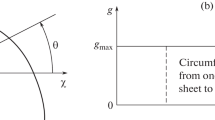Abstract
The calculation of supersonic flow past three-dimensional bodies and wings presents an extremely complicated problem, whose solution is made still more difficult in the case of a search for optimum aerodynamic shapes. These difficulties made it necessary to simplify the variational problems and to use the simplest dependences, such as, for example, the Newton formula [1–3]. But even in such a formulation it is only possible to obtain an analytic solution if there are stringent constraints on the thickness of the body, and this reduces the three-dimensional problem for the shape of a wing to a two-dimensional problem for the shape of a longitudinal profile. The use of more complicated flow models requires the restriction of the class of considered configurations. In particular, paper [4] shows that at hypersonic flight velocities a wing whose windward surface is concave can have the maximum lift-drag ratio. The problem of a V-shaped wing of maximum lift-drag ratio is also of interest in the supersonic velocity range, where the results of the linear theory of [5] or the approximate dependences of the type of [6] can be used.
Similar content being viewed by others
Literature cited
A. Miele and D. G. Hull, “Three dimensional lifting wings of minimum drag in hypersonic flow,” Rice University, Dep. Aero-Astronaut. Rept. No. 26 (1966).
A. Miele and D. G. Hull, “Three-dimensional wings of maximum lift-to-drag ratio in hypersonic flow,” Rice Univ., Dep. Aero-astronaut., Rept. No. 27 (1968).
G. I. Maikapar, “Wing with maximum lift-drag ratio at hypersonic velocities,” Prikl. Mat. Mekh.,30, 136 (1966).
A. L. Gonor and N. A. Ostapenko, “Hypersonic flow past wings with a Mach system of shock waves,” Izv. Akad. Nauk SSSE, Mekh. Zhidk. Gaza, No. 3, 104 (1972).
V. M. Shurygin, “V-shaped wings in supersonic flow,” in: Collection of Theoretical Papers on Aerodynamics [in Russian], Oborongiz, Moscow (1957), pp. 371–425.
V. I. Lapygin, “Normal force of a plane delta wing in a supersonic flow,” Izv. Akad. Nauk SSSR, Mekh. Zhidk. Gaza, No. 3, 162 (1977).
V. I. Lapygin, “Calculation of supersonic flow past V-shaped wings by the method of stabilization,” Izv. Akad. Nauk SSSR, Mekh. Zhidk. Gaza, No. 3, 180 (1971).
V. I. Lapygin, “Solution of the problem of flow past a V-shaped wing with a strong shock wave on the leading edge,” Izv. Akad. Nauk SSSR, Mekh. Zhidk. Gaza, No. 3, 114 (1973).
G. G. Chernyi, Gas Flow with a High Supersonic Velocity [in Russian], Fizmatgiz, Moscow (1959).
Author information
Authors and Affiliations
Additional information
Translated from Izvestiya Akademii Nauk SSSR, Mekhanika Zhidkosti i Gaza, No. 3, pp. 128–133, May–June, 1986.
We note in conclusion that this analysis is valid for those flow regimes for which there are no internal shock waves in the shock layer near the windward side of the wing.
Rights and permissions
About this article
Cite this article
Lapygin, V.I., Tret'yakov, P.V. Conical wing of maximum lift-drag ratio in a supersonic gas flow. Fluid Dyn 21, 445–450 (1986). https://doi.org/10.1007/BF01409732
Received:
Issue Date:
DOI: https://doi.org/10.1007/BF01409732




